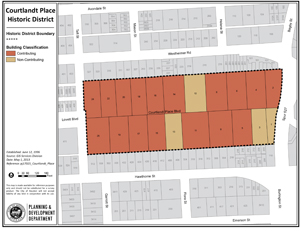

Courtlandt Place
About
Courtlandt Place was established in 1906 as an exclusive and elegant neighborhood. It is one of the few old Houston subdivisions that is still intact. Courtlandt Place includes 18 grand historic homes, built between 1910 and 1937, along a tree-lined boulevard.
Houston has been a major shipping and trade center since its founding in 1836. During the 1800s, city leaders invested in the development of railroads and Houston’s network of bayous. The Houston Ship Channel and Port of Houston, built in the early 1900s, had far-reaching effect on the City and drove the city’s tremendous growth. Between 1900 and 1910, the population doubled. It doubled again between 1910 and 1920 – creating an urgent need for new housing.
Many wealthy professionals had lived along Main Street, near their downtown offices. They began to move out of downtown into new, exclusive neighborhoods. Several of those neighborhoods were built southwest of downtown. They include Courtlandt Place, Westmoreland, Audobon Place, Avondale, Boulevard Oaks, and Broadacres.
The Courtlandt Improvement Company was incorporated in 1906. The men who formed that company were A. J. Hamilton, T. A. Cargill, and Sterling Myer. They bought just over 31 acres of land and platted 26 large lots. Twenty-four of the lots measured 100 feet by 170 feet. The two lots on the east end of the subdivision were larger. A wide street was built with four grassy islands down the middle. Two alleys, parallel to the boulevard, were built down the outside edges of the neighborhood.
A crescent-shaped entrance to the neighborhood, with formal gates, was built on the two larger lots at the east end of the street. Another wall was built in 1912 to block the west entrance to the neighborhood. It was designed by architect William Ward Watkin. The wall was built to prevent through-traffic to the adjacent Montrose area. It was removed after Montrose’s developer complained to City officials. In return for opening up the roadway, the City paved Courtlandt Boulevard and installed streetlights.
The developers created six deed restrictions for the neighborhood. No businesses could be built in Courtlandt Place. Only one residence could be built on each lot, and it had to be at least two stories tall. All houses had to cost at least $10,000. All houses had to be set back about the same distance from the street. Outbuildings could only be built at the rear of the property, and fences could only be built around outbuildings. Hedges could not be more than three feet tall within 50 feet of the front property line. (In other words, tall hedges could not extend very far past the front of the houses. That ensured a clear view up and down the neighborhood.) Finally, the Courtlandt Improvement Company reserved the right to control streets, sidewalks, parks and property abutting Courtlandt Place.
The deed restrictions were created “in perpetuity,” which means that they will never expire. That ensured that the neighborhood would keep its original character over the years. Although many of Houston’s subdivisions had deed restrictions when they were built, most of those were allowed to lapse. Courtlandt Place is one of the only neighborhoods in Houston that has kept its deed restrictions in place over time.
The first lots in Courtlandt Place were sold in 1907, but no construction started until 1910. By 1912, twelve lots had been sold and six homes were completed. Eight more homes were built over the next five years. The last of the neighborhood’s historic houses was completed in 1937. Many of the houses in Courtlandt Place were designed by well-known architects.
The construction of US 59 Spur 527, in 1969, destroyed the east entrance to the neighborhood and part of two lots. The neighborhood association saved the stones from the pillars and the wrought-iron gates. In 1974, they used some of those materials to build the current east entrance.
Courtlandt Place, like many older neighborhoods, declined during the 1960s and 1970s. Crime, litter, and vagrancy spilled over from nearby Montrose. Residents decided to combat these problems. In the 1980s, they built another wall to block off the west entrance.
The residents also worked to get the neighborhood listed on the National Register of Historic Places in 1980. Eleven houses in the neighborhood have been listed individually on the National Register as well. Five of the houses are individually designated as City of Houston landmarks.
A few newer houses have been built in the neighborhood. The house at #13 Courtlandt Place was built in 1977-78. It is smaller than the old Courtlandt Place houses and has a one-story attached garage, instead of a separate garage behind the house. However, #13 Courtlandt Place meets the requirements of the deed restriction and maintains the residential quality of the neighborhood. Another house was built in 1985 at #1 Courtlandt Place on what was a vacant lot. To date, none of the original homes have been demolished.
In 1989, the residents formed a new civic association to help manage the neighborhood, the Courtlandt Place Historical Foundation. That organization also hosts tours and otherwise promotes the neighborhood.